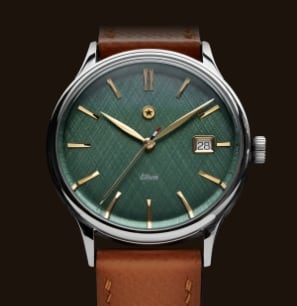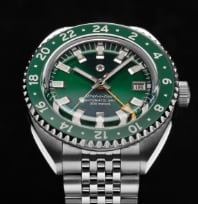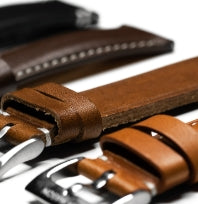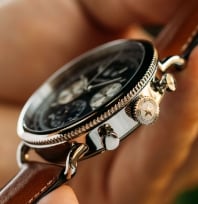Throughout history, we’ve always been driven to explore the world around us. People have trekked vast deserts, incredible mountains, the outer reaches of space, and the mysterious depths of the ocean. In each of these instances, they’ve needed special tools to help them.
All watches tell time, but dive watches tell us a lot more.
The Purpose of a Dive Watch
On a fundamental level, dive watches are watches designed for functioning well in an environment most machines don’t naturally work well with: Underwater. The slightest bit of moisture inside a watch can damage the interior. There is nothing worse for a timepiece that occurs in anything other than the most extreme circumstances than being waterlogged.
All watches tell time, but dive watches take this capability and make it a life or death situation. Telling time is critical underwater because oxygen is a finite resource. Staying underwater for too long can result in oxygen deprivation and even death, forcing dive watches to be held to an exacting standard.
Dive Watch Complications
Compared to other sport watches, dive watches may seem a little feature-lite when it comes to complications. In dive watches, legibility is of the essence, causing many visual complications to be eschewed in favor of a simple face, though date windows and other such features are common.
The reason for this is twofold: The interior of a dive watch must remain legible, and water must remain outside of the timepiece at all costs. Chronographs and other complications which push into the watch risk breaking the airtight seal, and special care must be taken when designing a dive watch with such features.
Dive Watch Complications
More commonly, dive watches showcase complications that directly impact underwater functionality.
These include:
-
Rotating Bezel: One of the main purposes of a dive watch is timing the length of a dive. By rotating the bezel of the watch, it is easy to mark the point where you began your descent. The most conscientious of dive watches feature bezels that only rotate one way to prevent overstaying your dive.
-
Screw-Down Crown: The opening of the crown stem poses one of the greatest risks for water to enter the piece. For this reason, many dive watches include a screw-down crown, which winds down directly into the case. Similarly, tight screwing mechanisms exist for casebacks as well.
-
Depth: Just because they are called diving watches doesn’t mean they can’t help you in your ascent. By measuring the depth you are at in the water while measuring the time you’ve spent underwater, you can help avoid the bends.
The bends occur when nitrogen in the blood changes states due to rapid changes in pressure, which can cause gas bubbles to form on the ascent. At best, the bends are a traumatic experience that may leave no lasting effects, but at worst, decompression sickness can easily cause death.
- GMT: When undergoing cross-time zone travel, either while underwater or while out on a boat, keeping track of time can be a boon so that you won’t have to readjust your watch.
While dive watches may have some complications available in regular sport watches, a variety of unique features make them distinctive in their own right when it comes to craftsmanship.
How Watch Materials React Under Water Pressure
To summarize the following and quickly answer the question implied by this paragraph heading: Badly. How badly they respond, however, depends on the type of water involved.
Contact with water causes iron to rust through a chemical process that is accelerated by the presence of salt. Due to the small size of watch parts, the smallest bit of rust can cause irreparable damage to the dial, hands, or movement of the piece.
The case and enclosed machinery aren’t the only aspects of a watch that are affected by water. Naturally, the strap is also impacted by moisture, depending on whether it is partially or wholly submerged and the nature of the moisture it is touched by.
Straps and Moisture
Below is how the most common types of straps are affected by moisture:
-
Stainless Steel: Stainless steel comes in a variety of compounds that are marked by overall high strength. While stainless steel is generally rust-resistant, some compounds are stronger in this regard. The 316L compound, in particular, is extraordinarily rust-resistant, giving it the name of “marine-grade” stainless steel.
-
Rubber: Few materials react as well to water as rubber straps. Rubber is wholly hydrophobic, meaning it does not absorb water and thus responds well to repeated exposure. The con of rubber is that if you are sweaty or in a humid area without using it in the water, it may feel sticky to the skin.
-
NATO Strap: NATO straps are long, single pieces, as opposed to the bifurcated design of most leather straps. The original NATO straps, as well as many today, are made out of nylon. As with most synthetic materials, nylon is highly hydrophilic. This means that while it absorbs water when submerged, it will hold up well as long as it is given enough time to dry adequately.
- Leather: All the above materials work well or at least passably in water, but leather is to be kept clear of water whenever possible. In small doses, water may stain the leather. In cases of full submersion, water can cause the leather to dry out and crack, weakening the strap and damaging its appearance. If you see yourself diving or engaging in water sports, either take your watch off or use a strap more appropriate for diving.
All in all, stainless steel and rubber provide the best protection in water depending on your personal aesthetics, nylon offers a lesser but still functional strap, and leather should be avoided.
ISO Standards
The International Organization for Standardization conducts a wide series of standardization tests for a variety of objects, including standards for water resistance and diver’s watches.
Two of these standards relate to watches in water:
- ISO 2281: Water resistance standard for all watches.
- ISO 6425: Various resistance and design standards for diver’s watches.
The first of these standards, ISO 2281, tests overall water resistance as well as specific reactions to temperature, condensation, and pressure. It is important that a watch be able to survive a given water pressure, changes in temperature from extreme heat and cold while protecting the interior components from the dangers of moisture.
Compared to ISO 6425, however, the testing involved here is fairly forgiving as it solely relates to performance in water.
ISO and Diver’s Watches
The phrase dive watch and diver’s watch may be used interchangeably, but there is a subtle distinction between the two. Dive watch refers to any watch designed for diving, whereas a diver’s watch refers to a watch that has been subjected to and passed the ISO 6425 design and testing standards.
6425 Standards for Design Include
-
Water Resistance: While higher water resistances are possible regardless of ISO certification, 100 meters is the minimum for a diver’s watch.
-
Elapsed Time Indicator: If a dive watch does nothing else, it needs to be able to function underwater and let the diver know how long their dive has been going on for safety’s sake.
-
Minute markers: Some minimalist watch dials only show hours markers, but discrete minute markers are essential when it comes to timing your dive.
- Legibility: A diver’s watch needs to be visible at a distance of 9.8 inches in total darkness and must also contain some indicator, such as a second hand, showing that it is actively running in similar darkness. Luminosity markings serve to fulfill both legibility requirements.
Must Pass These Endurance Tests
-
Magnetism: Magnetic interference, as passively deployed by a variety of devices, can cause the gears of a watch to jam together, resulting in lost time or stopped movements. In order to pass muster, a watch must be exposed to a high degree of magnetism without losing more than 30 seconds per day.
-
Shock: Out of all the tests the ISO 6425 mandates, this one seems the cruelest to timepieces. The watch must be struck twice, once on the 9 o’clock position and once on the crystal, with a plastic mallet. After this damage is sustained, the watch must remain accurate within a minute per day of run time.
- Chemical resistance: The watch must function after 24 hours of submersion in a solution that mimics normal saltwater, ensuring that watches can survive dives of the longest duration.
The above are only the major testing requirements for the ISO, with the strap and other minute details of each individual watch also being tested. All in all, the ISO provides some of the most in-depth testing of watches out of any organization.
Is ISO Testing Necessary?
Just because a dive watch lacks ISO 6425 testing doesn’t mean it isn’t a high-functioning timepiece. There are many reasons a manufacturer may decide against testing, including the cost.
Every single watch made from a model must be voluntarily subjected to each test. This makes it prohibitively expensive and time-consuming, depending on the specifics of a model’s batch size and other factors.
While ISO 6425 testing ensures a high-quality diver’s watch, there’s no reason a watch that doesn’t have these standards applied can’t stand as an excellent offering. Ultimately, water resistance testing and examination of a watch’s physical design features can be a good metric to judge a dive watch in the absence of ISO 6425 indication.
Dive Watch History
Prior to the invention of quartz watches, all watches were made from intricate mechanical components. Many things could go wrong with antique watches. These problems included the eventual degradation of components, shocks from dropping or accidentally striking the timepieces, and magnetism in an increasingly industrial world, causing the gears to stick together. Lastly, constant maintenance was necessary to help the timepiece accurately convey the time, especially after sustaining damage.
In modern Horlogerie, all of these issues have been, if not totally solved, wonderfully safeguarded against, melding survivability and aesthetic beauty in one frame. Arguably, however, there was no bigger threat to the mechanical workings of a watch than moisture.
Prior to the 20th century, there was no such thing as a waterproof watch. However, in 1927, Mercedes Gleitze became the first British woman to swim the English channel, creating a new world record.
Unfortunately, her claim was put into question when another woman purported to have swum the channel faster. In a bid to quell the (later proven false) rumor, Gleitze undertook a “vindication swim” a mere month later, with a historic addition to her swimming gear.
First of its Kind: Waterproof Watch
In 1926, one year prior, Rolex produced the Oyster, hailed as the world’s first waterproof watch. One year later, with the vindication swim in the national consciousness, one watchmaker saw the chance to validate his work. Rolex cofounder Hans Wilsdorf sent Gleitze a letter in which he promised to gift her an Oyster for her swim in exchange for her release of a testimonial to the quality of the watch following her swim.
The vindication swim was ill-fated. During her previous successful voyage on October 7th, the water temperature was in the pleasant 60s. Two weeks later, the chill of late fall set in, with water temperatures ranging from 51 to 58. Though seemingly a small change, the icy waters proved treacherous even for a swimmer at the top of her fame.
Ten hours in, with seven miles left to go, Mercedes Gleitze had to be pulled from the water and medically examined, though her exemplary performance under such poor conditions erased all doubt that she was anything but a champion.
Though the swim was unsuccessful, the performance of the Oyster was, and the world’s first waterproof watch survived trial by water.
The Testimonial
Incidentally, Gleitze did eventually give her promised testimonial that the Rolex Oyster watch was “a reliable and accurate timekeeping companion” despite the submersion in significantly cold water for incredible stretches of time.
Waterproof No Longer
While the Rolex Oyster was the first “waterproof watch” in 1926, there is not a single timepiece made today which is to boast that quality. Watches have greatly improved in almost 100 years, so why is this so? Through rigorous testing, it became apparent that “waterproof” is more of an attractive phrase; no watch is truly waterproof.
Calling a watch waterproof is misleading, to the point that advertising a watch as such is actually illegal in the U.S. As a watch ages, repeated strain reduces its effective water resistance, making any claim to being waterproof dubious.
After all, if the 1926 progenitor was truly waterproof, we’d be seeing Oysters that have spent 95 years on the wrists of swimmers with only minor repairs needed, rather than being treated as the antiques they are. In lieu of waterproofing, modern watches use water-resistance testing to refer to their capability in the water.
The water-resistance of a watch can often be found listed on the back of the case, or failing that, on the manufacturer’s website. “Water-resistance” refers to the water pressure exerted when static at a particular depth, measured in either meters or atmospheres (ATM), with one atmosphere equally ten meters.
The tricky part with gauging the practical water resistance of a watch is in the phrase “static.” Movement, whether of a body through water when swimming or of water on a body as in a shower or sink, causes a higher degree of pressure to be exerted, meaning you probably shouldn’t be taking your 3 ATM watch in the pool with you.
There are some other extenuating factors that impact the effective water resistance of your watch. Just as cold water caused Mercedes Gleitze to falter, hot water also puts a greater strain on the water-resistant elements of your watch.
The heat of the water and the chemicals of soaps and lotions all spell risk for your wristwatch. It won’t necessarily cause damage after a single or even a few washes; we recommend avoiding taking your watch in the shower or hot tub with you for the sake of longevity.
The Real Meaning of Water Resistance Markers
Water resistance markers don’t necessarily mean your watch can be used at the exact depth they list.
Below is a handy guide to get a better feel of the practical usage of your watch:
-
No marker: This watch is not water resistant at all, and you should avoid moisture whenever possible. The exception is if you see “ISO 6245” listed on the watch, which means the watch is automatically rated at a minimum depth of 100 meters.
-
30 Meters/3 ATM: At this rating, your watch is splash resistant, meaning it’ll be fine when washing your hands or in other contexts where it may be exposed to small amounts of water. Avoid taking it in the pool with you, though.
-
100 Meters/10 ATM: At this point, you can start having some fun with your timepiece. Feel free to go swimming or snorkeling, but leave the deep-sea expeditions to watches better designed to endure them.
- 300 Meters/30 ATM: Ratings of 300 meters and above make for high-powered diving equipment. These watches truly belong underwater, and if you’re wearing one on your wrist, you’re most likely fresh out of the water or eagerly awaiting your next voyage.
What Makes a Watch Water Resistant?
While understanding the factors that go into water resistance is front-loaded, explaining what makes a watch water resistant is comparatively simple. In order to prevent a watch from water damage, O-rings made of hydrophobic materials such as rubber, coating in oils to further expel water, are used in the formation and maintenance of gaskets.
Gaskets are used in machines of all sizes, from watches to cars, to prevent dust or moisture from entering where two uneven surfaces meet. O-rings are required, among other places, where the crystal meets the case, and any interactive component that may let water in, such as the bezel, crown, or chronograph pushers.
Many diving watches include screw-down crowns, where the crown stem directly meets the watch case to further protect the piece from water and dust. Otherwise, these elements may break the hermetic seal created by the watch, letting water in and potentially damaging the watch.
The Seatrek Automatic
Now that we’ve gone deep into every desirable feature of a dive watch, it’s time to see how Jack Mason’s offerings hold up with the Seatrek Automatic.
The Seatrek Automatic is water tested at 300 meters and has a case made from marine-grade 316L stainless steel, making it a deep-sea voyager for the ages. A screw-down crown and tightly locked-on caseback aids in protecting the interior components.
The Seatrek also comes with a unidirectional bezel, which, while not a standard feature, is an essential one for divers. Because the bezel turns in one direction, moving it accidentally will only result in a perceived increase in dive time, keeping you safe as well as the watch itself.
Compared to regular watches, the Seatrek Automatic has something inside worth protecting in the way of its Seiko Caliber NH35A movement, powered by the movement of your wrist, housing 24 jewels, and boasting an impressive 41-hour power reserve.
Looks and Matter
Just as much care has been put into the external appearance of the Seatrek Automatic. It boasts a sleek monochrome appearance with a black dial and white numbering and indices in one version. The other iteration features a navy dial with partial orange highlights on the hand and bezel.
A date window placed at the 3 o’clock position adds a dash of functionality without compromising the slightest bit of protection. Speaking of function: Bicolored SuperLuminova markings on the hands, indices, and bezel make it easy to read the watch whether you’re diving at night or plunging to a depth where sunlight becomes an issue.
The box set comes with a 316L stainless steel strap with diver’s extension to maximize comfort, style, and corrosion resistance. It also has a rubber strap to offer a different, albeit still water-effective appearance.
The case, and overall design, are heralded by the exhibition caseback, where a bathysphere, representative of humanity’s earliest attempts at deep-sea exploration, is illustrated in full while surrounded by the waves of the sea and the design features which contribute to the effectiveness of the Seatrek Automatic.
For a watch that goes the distance underwater and provides a cutting silhouette on solid ground, the Seatrek Automatic makes a compelling case for an all-terrain timepiece.
For Additional Consideration: The Seatrek
Newly added this summer: the Seatrek boasts many of the same design features that make the Seatrek Automatic so popular. The protective 42mm stainless steel case, screw-down crown, legibility markers, and bathysphere backing all make an appearance, complemented by a bold new visual language and internal movement.
The Seatrek features a black dial and bezel, with boldly orange hands, indices, and bezel markers. The piece also comes with a unique orange rubber strap, making it go the distance whether you’re poolside, lakeside, or down below the waves.
Supposing you want to trade the bold visual language when you wear the piece indoors in cooler months, quick-release straps make the Seatrek compatible with any Jack Mason 22mm strap. Whether you keep the bright, eye-catching orange strap or trade it in for a subtler brown or black leather, the Seatrek remains an exemplary piece of gear for any traveler.
The Seatrek uses a Miyota 2315 Caliber quartz movement. With this type of movement, you’ll be able to strap it on your wrist without needing to wind or rotate it for the movement to keep time. This is perfect for when you’ve got a packed itinerary and convenient even when you’re scheduled to relax by the shore.
Modern Diving Gear: Watch vs. Computer
Some diving gear is a no-brainer: Everyone who plans to go more than a few feet underwater needs both dive-appropriate attire and a source of oxygen, but another tool that has seen increased use is the diving computer.
While dive computers resemble watches in some way, they are a specialized tool made specifically and exclusively for dives. Computers keep time and can be used to set depths, measure oxygen levels, and track the rate of ascent for divers. In short, dive computers do many things a dive watch does, along with other specialized traits.
The biggest visual difference, of course, is that a dive watch is a timepiece that functions equally well in and out of the waves. On the other hand, dive computers are analog devices that look out of place as part of your daily attire.
Some use dive computers, some use dive watches, and others rely on dive computers while wearing a dive watch as a backup in case of primary mechanical failure. If you only see yourself wearing something to aid you on dives, then a dive computer may be in your best interest. If, however, you want a powerful, statement piece sport watch that is truly as practically functional as it is starkly fashionable, go with a dive watch.
Final Examination on Dive Watches
As long as water has captured our attention, we’ve made designs to help us navigate it. From boats to bathyspheres, to scuba gear, to watches, we’ve fine-tuned the smallest of machines to give us the edge.
You may not always wear a dive watch to undersea expeditions, but one thing is certain: Now, you have a better look at the ingenuity and evolution of this surprisingly complicated piece of watchmaking history.
Sources:
Related How Does Salt Water Rust Metals? I Sciencing
ISO 6425 I International Organization of Standards
Decompression Sickness | Harvard Health
Champion swimmer and record breaker Mercedes Gleitze | Brighton Museums







